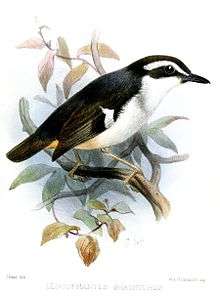Black-chinned robin
| Black-chinned robin | |
|---|---|
 | |
| Scientific classification | |
| Kingdom: | Animalia |
| Phylum: | Chordata |
| Class: | Aves |
| Order: | Passeriformes |
| Family: | Petroicidae |
| Genus: | Poecilodryas |
| Species: | P. brachyura |
| Binomial name | |
| Poecilodryas brachyura (Sclater, 1874) | |
| Synonyms | |
|
Leucophantes brachyurus protonym | |
The black-chinned robin (Poecilodryas brachyura) is a species of bird in the family Petroicidae found in Indonesia and Papua New Guinea. Its natural habitat is subtropical or tropical moist lowland forests.
Described by English naturalist Philip Sclater in 1874, the black-chinned robin is a member of the Australasian robin family Petroicidae. Its genus name is derived from the Ancient Greek words poikilos "little" and dryas "dryad", and the species name brachyura is derived from the Ancient Greek words brachys "short" and ouros "tail". Sibley and Ahlquist's DNA-DNA hybridisation studies placed this group in a Corvida parvorder comprising many tropical and Australian passerines including pardalotes, fairy-wrens, honeyeaters and crows.[2] However, subsequent molecular research (and current consensus) places the robins as a very early offshoot of the Passerida (or "advanced" songbirds) within the songbird lineage.[3]
Measuring 14 to 15 cm (5.5–6 in), the black-chinned robin has dark brown to black head and upperparts with a prominent white stripe or "eyebrow" above the eye. The chin is black immediately under the bill. Its tail is markedly shorter than other Australasian robins. The throat and underparts are white, and there is a white bar on the otherwise dark-plumaged wing. The bill is black, the eyes are dark brown, and the legs pale brown or pink. Its song is a descending series of notes and resembles that of the fan-tailed cuckoo.[4]
The black-chinned robin is found predominantly in the lowland forests of northwestern and central New Guinea (mainly in West Papua and only a little in Papua New Guinea's northwest) from sea level to 650 m (2000 ft). Within the rainforest it is found in pairs in the understory or on the ground. It is insectivorous, and hunts by gleaning. It is a weak flyer.[4]
References
- ↑ BirdLife International (2012). "Poecilodryas brachyura". IUCN Red List of Threatened Species. Version 2013.2. International Union for Conservation of Nature. Retrieved 26 November 2013.
- ↑ Sibley CG, Ahlquist JE (1990). Phylogeny and Classification of Birds: A Study in Molecular Evolution. New Haven, CT: Yale University Press. pp. 603, 610–27. ISBN 0-300-04085-7.
- ↑ Barker, F. Keith; Cibois, Alice; Schikler, Peter A.; Feinstein, Julie & Cracraft, Joel (2004). "Phylogeny and diversification of the largest avian radiation" (PDF). PNAS. 101 (30): 11040–45. doi:10.1073/pnas.0401892101. PMC 503738
 . PMID 15263073. Retrieved 2008-08-14.
. PMID 15263073. Retrieved 2008-08-14. - 1 2 Coates, Brian J. (1990). The Birds of Papua New Guinea. Volume II. Queensland: Dove Publications. p. 190. ISBN 978-0-9590257-1-2. OCLC 153651608.
